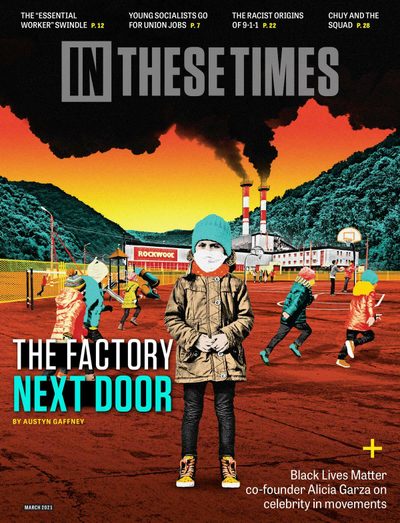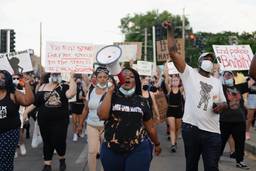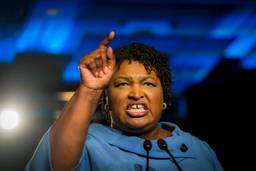Alicia Garza on the Problem of Celebrity in Social Movements
Black Lives Matter co-founder Alicia Garza reflects on platforms and pedestals.
Alicia Garza

Movements that are able to enter the mainstream are likely to see their leaders thrust into the public eye. Rosa Parks was selected for the role she played because of the symbolism she could project — a hardworking seamstress whose feet were tired after a long day was the perfect symbol for a lawsuit later filed by the NAACP on her behalf in an attempt to unravel segregation. Martin Luther King, Jr.’s appeal was that he was a man of faith, a moral compass for his parishioners and, later, for the soul of the nation. Malcolm X, finding Islam after having seen hard times, was able to provide answers for Black people on how to reclaim our own humanity.
These three did not select themselves as figureheads — they were strategically selected by the movements that elevated them to communicate their vision and goals.
After gaining prominence, these leaders had to make sense of the authenticity of their roles while at the same time trying to figure out how to use their new platforms for the collective good. And for some of these leaders, gaining a platform and increasing their public profile was accompanied by jealousy and ridicule from their peers, increased pressure, threats and harassment from their opposition, and an onslaught of insecurity and self-doubt.
I’ve been organizing since I was 22. When I was a local organizer, knocking on doors and leading campaigns in Bayview Hunters Point, Calif., I was relatively unknown until I helped run a campaign that took on a major housing developer. In order to win our campaign, we had to operate on the same terrain that our opponent did — which meant we had to take our fight to the media. There were many leaders in that campaign, and why I was the one to gain visibility was the result of many factors, but a large part of it was an intentional strategy by our coalition. I had a formal education and two degrees from a highly ranked public university, which gave me particular skills, including the ability to write op-eds and articles about our work. I was not seen as a polarizing figure by the communities that we were organizing, or a figure who had an agenda — even though I did have one.
I was both a trained organizer and an organizer in training, which meant that I’d learned valuable tools for how to build relationships with people I’d never met before and how to agitate them to get involved in our campaign and eventually become leaders within it. As an organizer in training, I was taught how to effectively communicate through the media by three strategists from the Center for Media Justice; at that time, the center worked to help community-based organizations clearly communicate their vision, values and alternatives through mainstream media platforms, which often did not share those views. When our opponent dropped nearly $3 million into a ballot measure campaign — on which we’d spent about $10,000 — so they could run ads on BET and send weekly mailers to voters, we understood we had to find our own ways to use mainstream platforms to win hearts and minds.
Even though we knew that to win we needed to reach as many people as possible, we were still uncomfortable with what that meant.
I spent a lot of time during that campaign writing op-eds, talking on the radio and debating our opponent in public forums. The local paper contacted me after the campaign to tell me I’d been selected as a “Local Hero,” which carried some prestige in the progressive organizing community. When I shared the news with a fellow organizer, they responded that it wasn’t me who should be acknowledged, but everyone who worked on the campaign. Further, they argued, I should refuse the honor if the newspaper didn’t agree to recognize the entire organization.
I was taken aback and a little hurt. It came from a person who would often shy away from playing any public role and would rationalize that it was inappropriate to do so because of their racial identity (they were white). I wasn’t particularly keen on playing as public a role as I did, as I too felt some discomfort based on the advantages I felt I had. Yet after months of 12- to 14-hour days, numerous debates and public engagements, and the heartbreak of having ultimately lost the campaign, I accepted there were those in my community who wanted to honor the work that I had done. As part of a coalition, I had been groomed to take on these roles. So, after putting in that work, why was I being punished for being effective and doing a good job in the role I’d been given?
I won a number of awards in the progressive community for my work on that campaign. Some of those awards were presented to the organization; some were presented to me. But it has raised an important question for me ever since: How should movements approach platforms, pedestals and profiles?
Technology and the rise of social media have made that question even more complex, shifting our understanding of leadership — and the responsibilities of a leader. Platforms, pedestals and profiles are new versions of old models. A platform in King’s day might have been a church congregation, whereas today a platform could be a social media page.
Profiles in Parks’ day revolved around who knew you and what they knew you for. Community members might have described Parks as a seamstress who became active in the NAACP in 1943, gaining the respect of her peers for her work registering Black people in Montgomery, Ala., to vote. Today, a profile is still based on who knows you and what they know you for, but instead of your community knowing “who your people are,” a profile might be a well-curated social media timeline of opinions and responses to the latest news, and the curation of relationships and visibility online.
A pedestal is what we place people on because we hold them in high regard. Malcolm X was placed on a pedestal by Black communities in particular, mostly for his ability to speak unapologetically about the effects of white supremacy on Black society, and also for encouraging Black people to defend ourselves and seek liberation “by any means necessary.” Placing people on pedestals can result in making people symbols without substance. Today, being placed on a pedestal can occur when you’ve built a strong enough brand — and yet the substance it’s connected to may or may not be a part of, or accountable to, a movement.
When Patrisse, Opal and I created Black Lives Matter, which would later become the Black Lives Matter Global Network, we’d all spent 10 years as organizers and advocates for social justice. Our platforms and profiles, and perhaps even pedestals, come from the relationships we have in our communities, the networks we are a part of, and the work we’ve done for migrant rights, transit justice, racial justice, economic justice and gender justice. For nearly a year, we operated silently, using our networks and our experiences as organizers to move people to action, to connect them to resources and analysis. Our work was to tell a new story of who Black people are and what we care about, in order to encourage and empower our communities to fight back against state-sanctioned violence. That meant our primary role, initially, was to create the right spaces for that work and connect people.
But when a well-known mainstream civil rights organization began to claim our work as their own, while distorting the politics and the values behind it, we decided to take control of our own narrative and place ourselves more prominently in our own story.
Every day, I wonder whether we made the right decision. It was important for us to be protagonists in our own story, but there were and are consequences to that decision. We were concerned about making sure that the vision and values of the thing we created were not being watered down or misconstrued.
Having a platform, and a profile that results from it, places you on a pedestal that, while it may have been earned, is not always desired. Most of the organizers I know who have gained a level of visibility are actually very private people, uncomfortable in the spotlight.
I remember the first time Patrisse and I were on CNN. It was December 2014, and we were invited to respond to the refusal of a grand jury to press charges against Officer Darren Wilson for the murder of Michael Brown and, days later, the decision of a grand jury not to press charges against Officer Daniel Pantaleo in the murder of Eric Garner. At that time, there weren’t many Black voices on major network news stations. There was Melissa Harris-Perry, who had secured her own show on MSNBC in 2012; Don Lemon, who had been a news anchor on CNN since 2006; and Roland Martin, a regular CNN contributor with his own show on TV One. Aside from them and a handful of others, Black anchors and commentators were few and far between.
The coverage of the movement was also a challenge. There were shots of angry protesters and property destruction, but rarely in-depth interviews with protesters. Black media, while somewhat varied on the topic, at least did the work to get underneath the systemic issues facing Black people in America. It was Black media that elevated young Black people who were the architects of not just protests, but organizations that were pushing demands to transform the systems that impacted our lives.
Patrisse and I did a short segment with CNN host Brooke Baldwin.
I remember sitting next to Patrisse on that set, nervous but determined. The news cycle was intent on discouraging protests, encouraging people to accept the decision of the grand juries, but Baldwin was an amicable voice who genuinely weighed all options. We were able to be clear on a few talking points that communicated that grand juries that refuse to bring charges against officers accused of murder are the norm and not the exception, that the families of the people who were killed deserve more than asking them to move on, and that Black Lives Matter would not stop fighting until we achieved justice for all of us.
When we unhooked our microphones and walked off the set, something had shifted in the trajectory of the movement. Black Lives Matter was no longer just a slogan that was being used across America. It wasn’t an aimless uprising without analysis, strategy or agenda. As we were leaving, we were stopped in the newsroom by a producer for another show that wanted us on. Black Lives Matter had been talked about in the news media for months; suddenly, the media had the people behind it to speak for it. Before we left that day, we’d taped three different segments on three different shows.
That was the beginning of a national and even international profile for the three of us as the cofounders of Black Lives Matter, individually and collectively. Profile was not something that any of us sought or seek for its own end. We didn’t go on CNN to build our brands — we agreed to go on because there were things that needed to be said that weren’t being said and troublesome assumptions that were not being challenged. We have sought to use media as a way to amplify not our own voices but the voices of those who would not otherwise be heard. And with the development of those profiles and those platforms, we have been both placed on pedestals and besieged by those who hope to knock us off them.
Movements can become antagonistic to those who break through barriers to enter the mainstream, where they can expose new audiences to the movement’s ideas. When Ai-jen Poo, currently the director of the National Domestic Workers Alliance and co-director of Caring Across Generations, built a profile and a platform based on her success leading domestic workers to win the first ever Domestic Workers’ Bill of Rights in New York State, it caused quiet rumblings within the movement that grew her. People were unsure whether it was a good thing that her fame had outgrown our small corner of the world. When Van Jones remade himself from an ultra-left revolutionary into a bipartisan reformer who landed in the Obama administration as the “green jobs czar,” the movement that grew him quickly disavowed him. Even when Patrisse Cullors began to grow a platform and a profile beyond the work I’d known her for at the Bus Riders Union, a project of the Labor/Community Strategy Center in Los Angeles, I received a call from one of her mentors questioning her ability to “lead the Black liberation movement.”
There are valuable critiques of the rise of individuals within movements. Some would argue that the larger movement can become overshadowed by a charismatic leader. And because individuals are fallible, there is a risk that too much attention on an individual can hurt the movement — particularly if that individual fails to represent the authentic aims and goals of the movement.
Another critique is that placing too much attention on individuals furthers the aims of the systems that we are trying to dismantle. Capitalism follows the logic of individualism, which teaches that we must compete against one another to survive. Capitalism monetizes everything, creating a dynamic in which absolutely everything, including movements, can be bought or sold. When an individual becomes the face of a movement to the wider world, the movement can be perceived through a capitalist lens: The individual becomes a victor in a competition for leadership and visibility, reaping the benefits of the labor of the movement.
Another valuable critique is that some who gain platform and profile from movements do not have the best interests of those movements at heart, and use their status as a springboard to become wealthy or attain celebrity.
These critiques pose valuable questions and contradictions for a movement to grapple with. Movements need to create change. That change is expressed sometimes through cultural shifts, sometimes through policy transformation. Either form of change requires power, and a movement’s source of power is masses of people. So movements must enter the arenas where millions of people engage — and those arenas are not always progressive.
What would the last period of civil rights have accomplished if its tactics and leaders had not been broadcast into homes across the nation? Would there have been a Black Power movement if it had not been, in part, adopted by some members in Hollywood? Would the women’s liberation movement of the 1970s have been as successful and widely known had there been no Gloria Steinem, no Ms. magazine? Can movements be content to be popular merely among those who are already familiar with them and those who directly benefit from them? Or do they need to create focal points — leaders, media, institutions — to become visible to the larger public?
We cannot know for sure, but those movements took advantage of the tools available to them to change the way of life for millions of people across the country.
Every actor within a social movement has a role to play and contributions to offer that at some point should be recognized. But the pedestals we create for individuals have the opposite effect: They obscure people’s contributions. They serve to situate the success of a movement inside one person, as opposed to that success being based on how much a movement grows beyond itself. At best, they turn people who are merely playing their roles into celebrities who are admired for their ability to “speak truth to power.” At worst, they assign roles to people who don’t deserve them— or to people who, in creating a cult of personality, themselves become a vestige of the social and economic systems we’re trying to dismantle.
Profiles and platforms are not inherently bad, and they can function as a helpful tool for movements to use. Pedestals, however, are rarely (if ever) of service in helping a movement achieve its goals and objectives.
I have traveled across the country talking with aspiring leaders who hope to make change in their communities. I’ll admit I die a little inside when people ask me, “How can I build my platform?”
Or when they introduce themselves to me as an “influencer.” No joke: A brilliant young Black sister recently handed me a business card that identified her as a “student influencer.” My response, sometimes through gritted teeth, is this: “For what and for whom are you building a platform and profile?”
I still do not believe that Twitter followers and Facebook friends represent the amount of influence you have. My friends who are digital organizers will kill me for saying this, and believe me, I mean no disrespect. If you have a million followers on Twitter, you are influencing something and someone. And yet the question remains: for whom, and for what?
Black Lives Matter started as a hashtag and then grew into a series of social media pages that connected people online. But it was when masses of people began to move in service of Black Lives Matter that it became effective. Imagine if we merely continued to tweet about our dissatisfaction without taking that displeasure directly to decision makers? Imagine if we had continued to just write about what’s wrong online without showing up at campaign fundraisers and news conferences, without establishing encampments in front of city halls and police stations. What impact would we have had? Would this even be considered a movement?
Black Lives Matter brought people together online to take action together offline. Solely organizing, educating, or pontificating online was never something that we considered to be effective organizing. But more than that, bringing people together offline requires building the relationships and infrastructure that can help grow the movement. Protests are never enough to build a movement. Protests need planning and preparation. Outreach and attendance. Follow-up. Security and safety plans. Messaging and targets. Demands. Cultural components. All of that requires vehicles that can give people things to be involved in between protests and off-camera.
For me, the only use for a platform or a profile is in the service of the strategy of a movement. I worry that we are encouraging people to build profiles and platforms without a strategy to win the changes we want to see in the world — to think they can change the world according to how many people follow them on social media. It doesn’t matter how many people follow me on social media if I am not moving them to do something amazing together offline. I’ve learned we need bases, not brands.
An edited excerpt from the book The Purpose of Power: How We Come Together When We Fall Apart by Alicia Garza. Copyright © 2020 by Alicia Garza. Published by One World, an imprint of Random House, a division of Penguin Random House LLC. You can buy the book online here.
Alicia Garza is an organizer, political strategist, and cheeseburger enthusiast. She is the principal at the Black Futures Lab and the Black to the Future Action Fund, cocreator of #BlackLivesMatter and the Black Lives Matter Global Network, director of strategy and partnerships at the National Domestic Workers Alliance, and host of the Lady Don’t Take No podcast.







